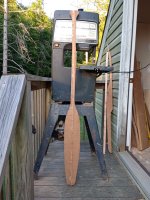I've been picking at this project off & on and thought I was about done... I shaped the laminated paddle into an ottertail and carved it as I did the Aspen paddle, using the spindle sander to true the blank to the offset lines & shape the grip, then applying the angle grinder to rough out the blade and, finally, smoothed the blade with the spoke shave, a small block plane and sandpaper.


I worked on the grip and handle of the Cherry beavertail but felt like I was going to have to shorten the blade by a couple of inches to make it work. My confidence in my ability to make a usable (and maybe even aesthetically pleasing) paddle was growing anyway so I decided to use the Cherry beavertail as a pattern to lay out the paddle that I really wanted: a Sassafras beavertail.
I had a couple of pieces of 5/4 Sassafras so I laid out the paddle using the grip & shaft from the Aspen paddle and the blade of the (too short) Cherry, simply tracing around them and blending them together at the throat. The Sassafras wasn't a particularly straight board but the 5/4 thickness allowed be to lay out the paddle in a way that I could take some of the warp out


One advantage of the Oak core in the laminated paddle is that the Oak resists sanding much better than Sassafras and I wound up thinning the throat of the paddle enough that there way a lot of flex in that area. Enough, in fact, that I was worried about it snapping on me so I epoxied some 4 oz e-glass around that area of the paddle to reinforce it.

Sorry that's blurry but I wanted to show that I didn't attempt to shape the glass patch much, I just wet it out & wrapped it around then flipped it over and did the same to the other side (patch above the paddle in the above picture) and this is what it looked like after & was done.

I wound up not using the paint brush and, really, not needing the tape. I'm relatively optimistic that it will hold and I was pleased that I would have 3 new blade shapes to try out. That should have been the end of it except that I cannot resist kicking around small sawmills and I happened to wander into one around Mount Union, PA who seems to specialize in weird woods. I picked up a few more 1x8x 8ft Sassafras and also 3 1x8x 8ft Catalpa, which I have been hunting for some time now.
The Catalpa was incredibly light and, unless my math is wrong, that 1x8x 8ft board should be 3/4 of a cubic foot. In that case, I may be building a Catalpa stripper soon as all 3 of those 1x8s weigh 12 lbs each. That would translate to 18 lbs / cubic ft which is considerably lighter than
Wood Database's figures.
As it was, I couldn't resist carving a piece of it into a paddle and, as the Sassafras was, seemingly, the most likely to break, I traced the outline onto the Catalpa 1x8 and started carving. I won't bore you with all the details of construction but I made sure I left it thicker in the throat. I also left a little more in the blade as I found that it planed & sanded unbelievably easy and I'm a bit worried about strength. One mill that I had checked previously said that he usually just threw Catalpa in with the Sassafras as "nobody can tell the difference". I find that a bit hard to believe as, yes, the appearance is probably indistinguishable but it is certainly much softer to work and the wonderful Sassafras smell is lacking.
Anyway, this is what I wound up with.

I'm hoping to oil all 4 paddles tomorrow and I'll post weights & measurements after they're dry.









